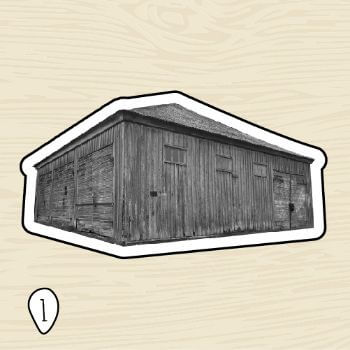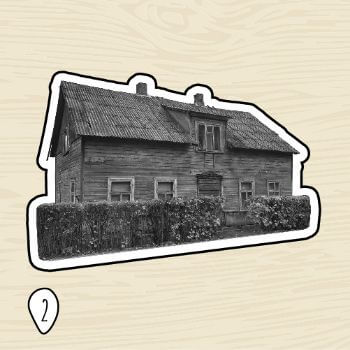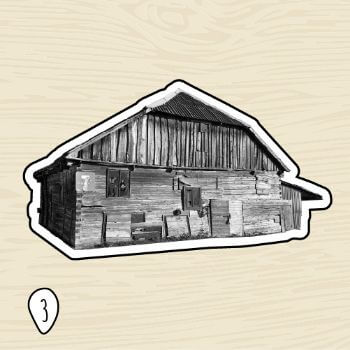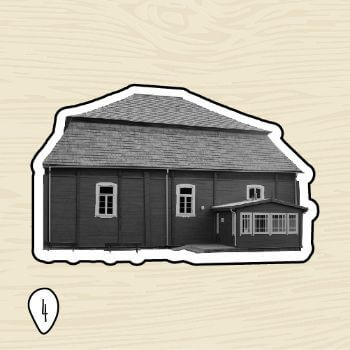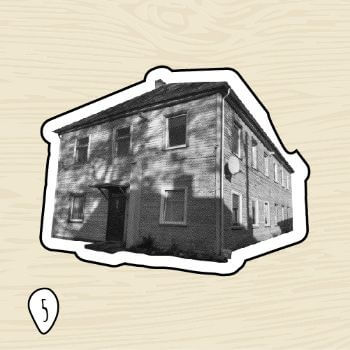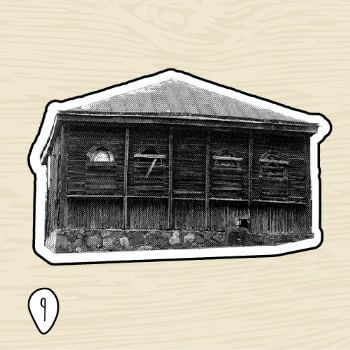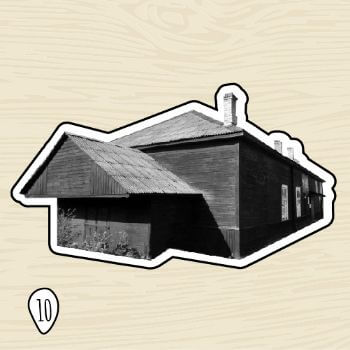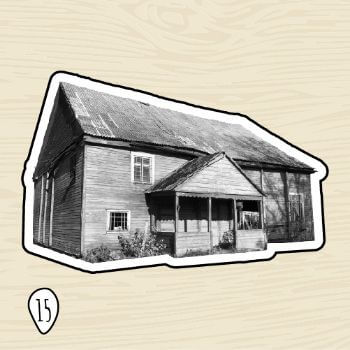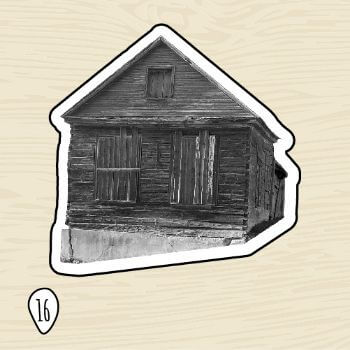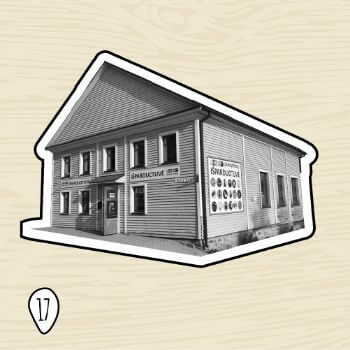Wooden synagogues
Wooden synagogues are unique objects of Jewish material heritage both in Lithuania and in whole Eastern Europe. At the moment we can count 16[1] extant wooden synagogues in the current territory of Lithuania. Two of these 16 synagogues has been reconstructed in recent years – in Pakruojis and Žiežmariai – and now they are open for public.
The wooden synagogue in Pakruojis, which now serves as a cultural center, is the oldest extant wooden synagogue in Lithuania dating back to 1801. The majority of other extant wooden synagogues are from the interwar period. During the Soviet occupation due to atheism politics of Communists` rule these synagogues has been misused as storage houses, sports halls or cultural centres of the towns. After Lithuania regained it`s independence in 1990, these synagogues gradually have been given back either to Jewish communities or to the local municipalities.
[1] Vištytis synagogue has been found to be a bricked synagogue, thus has to be discounted.

1. SYNAGOGUE OF ALSĖDŽIAI
Located on the stunning banks of the Sruoja stream, the town of Alsėdžiai in north-western Lithuania is also a part of the cultural heritage of Lithuanian Jews. A wooden synagogue built on the small hill in 1932-1934 is present to this day. Before the Second World War this prayer house was surrounded by the homesteads of local Jews, who went to pray to this synagogue. However, today only the Rabbi’s house on the other side of the road from the synagogue is extant. If you are not aware of the exact coordinates of the synagogue, you can also go to the detective hike – in 1990s the synagogue building, which was used as a storage house during Soviet period, has been completely reconstructed, thus you either need to be an expert or have a very vivid imagination in order to recognize the building as it was originally intended – as a synagogue.
2. SYNAGOGUE OF TIRKŠLIAI
Since the 18th century there has been a small Jewish community in the northern Lithuanian town of Tirkšliai. At the very end of the 19th century this community built a wooden synagogue in the main street of Tirkšliai, and this synagogue building is still intact to this day. With vanishing of local Jewish community during the Holocaust, after Soviet reoccupation this building has been used as a storage house. Previously the synagogue had two entrances, also the interior was divided into the main prayer hall in the East and women`s section in the West part of the building. These divisions have not survived until today, but through a peeling layer of a new paint it is possible to identify, that the interior of synagogue has been painted in light blue. Before the Second World War this synagogue was also famous as a local library holding a huge collection of books both in Hebrew and Yiddish languages.
3. SYNAGOGUE OF ROZALIMAS
In the 19th century Jewish community in Rozalimas was growing rapidly, so it felt a need to build a common prayer house for the community. In the years 1880-1881 local Jewish community built a wooden synagogue, which is extant to this day. The building stands not far away from the centre of the town, and it has maintained its primary original exterior. There are still visible two separate entrances to the building. During the Soviet period the synagogue has been used as a storage house and in order to make it more practical for such purpose the clear partitions between main prayer hall and women’s section have been eliminated. In front of the synagogue, on the other side of the road there is also still extant building of the Rabbi’s house. Both of these buildings as a complex now remind passers-by about the Rozalimas Jewish community, which no longer exists.
4. SYNAGOGUE OF PAKRUOJIS
Pakruojis is a unique example of Lithuanian shtetl – to this day there are still many extant wooden buildings, which changed so little since the interwar years. A little bit further from the previous Jewish shops, on the hill at the south bank of river Kruoja there is an extant oldest wooden synagogue in Lithuania (built in 1801), which has been restored in 2017. During the interwar period the building has been used as both a prayer house and a primary school, during Soviet times it was a local cinema theatre, and after that – a sports hall, and since Lithuania regained independence it waited to be renovated. Now refurbished building of synagogue functions as a place for cultural activities in Pakruojis. In the balcony, which used to be women’s section of a prayer house, there is an exhibition about Jewish history in Pakruojis. Authentic synagogue wall paintings with nature motives has been revived during the restoration, so the building itself without official declarations functions as a wooden synagogue museum.
5. SYNAGOGUE OF JONIŠKĖLIS
In the small town of Joniškėlis alike in Troškūnai, history of Jewish communities, which lived there since the 18th century, is reminded not by extant the material objects, but by the stories told by locals. In Joniškėlis Jews lived mostly around the market square and their extant wooden synagogue is only a few hundred metres south from this square. However, only the exterior walls of this green building reflect the previous function of the synagogue – after the Second World War synagogue has been rearranged to the private living spaces.
6. SYNAGOGUE OF ZARASAI
Although individual Jewish families in Zarasai have been mentioned already in the 17th century, communal Jewish settlement in the town began only in the beginning of the 19th century. The majority of new Jewish settlers in Zarasai came from a former Trakai Jewish community, which as economic rivals has been evicted by Trakai Karaite community. Newly settled Jewish community in Zarasai concentrated in the strategically most convenient part of the town – around the market square. Active Jewish life in Zarasai is well reflected by the fact, that at the end of the 19th c. there have already been six Jewish prayer houses. Two of them survived to-this-day – the great mural synagogue and humble wooden synagogue on the banks of Zarasas Lake. The extant wooden synagogue has been reorganized to a residential house, which being a two-story building stands out of other nearby residential houses in the street.
7. SYNAGOGUE OF TROŠKŪNAI
There are several apartment houses in Troškūnai, but there is only one such four apartment building, which a little bit more than half a century ago has been dedicated to read Torah and study Talmud, to celebrate bar micva or to pray – for men on the ground floor and for women in the separate women’s balcony. An active Jewish community has been living in Troškūnai for two centuries, but the whole community has been killed during Holocaust, and only the buildings now remind us of its history in town ‒ wooden synagogue built at the beginning of the 20th century and Rabbi’s house next to it. However, without existing local Jewish community the synagogue building have lost its practical purpose and have been pragmatically adapted to the needs of local citizens immediately after the war. 12 synagogue windows with white shutters now frame daily life of local Lithuanians.
8. SYNAGOGUE OF KURKLIAI
Due to the destructive fires since the 18th century Jewish community in Kurkliai have rebuilt their synagogue more than once or twice. The last and still existing wooden synagogue in the town was built in 1936. It has a traditional synagogue layout with the main prayer hall and women’s section. However, the décor of the synagogue has a few expressionistic features, for example, exceptional turret uncommon to Litvak synagogues. Still, this more extravagant turret was decorated with traditional symbols – two stars of David. After the Second World War with the vanishing of local Jewish population this still relatively new synagogue building has been made into storage house. After Lithuania regained its independence in 1990, the building has been left without any function. However, repair works have started lately.
9. SYNAGOGUE OF ALANTA
Since the end of the 19th century a Jewish community of around 200 people has built itself a home in Alanta, and home of religious Jewish community is not a real home without a synagogue. Wooden synagogue with a separate women’s balcony, two entrances and even with the heating (a real luxury of that time!) was open in Alanta until 1941. After the Second World War 10 windows of synagogue have been nailed up and the building was used by the citizens of Alanta as a collective storage house for grains. Even though the current condition of the synagogue is not the reflection of its golden times and the wooden building stands in solitude, the environment around it has been tidied up, there are informational signs, introducing everyone interested in the heritage of Jewish community of Alanta.
10. SYNAGOGUE OF VARĖNA
Varėna, alike the majority of Lithuanian towns before the Second World War, was a typical Eastern European shtetl. An active Jewish community has lived and prospered in this small town of southern Lithuania: there were Jewish religious and secular schools, Jewish People’s Bank, Jewish bookstore and even three synagogues. The current extant wooden synagogue has been the only one rebuilt after the First World War in 1922. The synagogue is distinguished by the modest décor and monumental size of the building. During the Soviet occupation synagogue has been reintroduced to the local population as a cultural centre for Varėna and after 1990s it is a private property. In 2018 this synagogue has been included into the Registry of Cultural values of Lithuania and now is protected by the State as a unique heritage of Lithuanian Jewish community.
11. SYNAGOGUE OF ŽIEŽMARIAI
Since the 16th century both Rabbinical Jews and Karaite Jews communities have settled in Žiežmariai. However, gradually Karaites left the town and Rabbinical Jews remained the only non-Christian minority in Žiežmariai. During the interwar period there have been secular Jewish school, theatre and Macabi club in Žiežmariai shtetl. A large and active Jewish community could not have existed without prayer house – already in the middle of the 19th century the first wooden synagogue has been built in town. Although the synagogue has suffered from several fires, each time it has been rebuilt and after the Second World War it was used as a storage house. Due to the initiatives of heritage lovers and protectors in Lithuania after 1990s this extant wooden synagogue building has been reconstructed respectfully to its historical meaning. There is an intention to open up a wooden-synagogue museum here.
12. SYNAGOGUE OF VEISIEJAI
In a spectacular oasis of southern Lithuania, surrounded by the Ančia Lake is the town of Veisiejai, which has been home for one of the Lithuanian Jewish communities since the beginning of the 18th century. For one year in 1886-1887 world-famous Litvak, creator of unifying Esperanto language, Ludwig Zamenhof has lived in Veisiejai. In 1748 with the first synagogue started the history of local synagogues – fire after fire one synagogue has been changed by another, but their location remained the same. The current extant wooden synagogue has been built in 1927 on the banks of Ančia Lake. It has almost preserved its originally structure to this day: a green-painted wooden two-storey building with a terrace and 12 large windows in the part of previous prayer hall is standing in Veisiejai as an unique example of multicultural history of the town. The building itself conditionally maintained its function as a prayer house – in 2004 there was established a church of local Baptist community.
14. SYNAGOGUE OF ŽEMAIČIŲ NAUMIESTIS
Already in the 17th century Jewish community started to settle in the town, which now is called Žemaičių Naumiestis. The first mural synagogue here has been built in 1816 and after the century the second, wooden synagogue, has been built as well. Both synagogues have survived the horrors of the Second World War. During the Soviet occupation the wooden synagogue, also known between locals as “women synagogue”, was reorganized into the local cinema theatre, and only one of two previous entrances was left. As a hidden gem survived original wall paintings of synagogue ‒ inside the building, beyond the newly placed cinema screen. However, both – two separate entrances and clear divisions inside the building – suggests that this wooden synagogue until the Second World War was a common prayer house for both Jewish men and women.
15. SYNAGOGUE OF LAUKUVA
Since the 18th century a small Jewish community lived in a little town called Laukuva. After the tragedy of Holocaust only macevas in old Jewish cemetery and a wooden synagogue in the centre of Laukuva built during the interwar period remind us of this community. After the Second World War this last Jewish prayer house in town has been repurposed and used as an auditorium for various cultural events. These changes of belonging and function have reflected in building’s exterior as well – a new entrance for a new crowd of visitors has been built in the south eastern part of synagogue’s façade.
16. SYNAGOGUE OF KALTINĖNAI
In the small town of Kaltinėnai Jewish community settled in only in the middle of the 19th century. The current extant wooden synagogue in the town was built even later – in 1938. The building has been designed to serve both as a synagogue and as a Rabbi’s living apartments. Symbolically, Rabbi’s apartments were designed as a lower annex next to a higher building part of a prayer house. The architecture of the building reflects modernization of Jewish religious life during the interwar period – although women’s balcony is still present, it has no separate entrance. The synagogue of Kaltinėnai has been ravaged during the Second World War and during the Soviet occupation it has been used as a storage house for work equipment. The current condition of synagogue building does not reflect the stirring Jewish community of interwar Kaltinėnai, it is more a reminder of the loss of Jewish community during the Holocaust.
17. SYNAGOGUE OF TELŠIAI
There was no other town like Telšiai in the whole Samogitia that would have been so attractive for Jewish community to settle and develop – in the end of the 18th century Jews had constituted about 80 percent of the local population. Historians fail to date the construction of the extant wooden tailors’ synagogue in Telšiai, but it has clearly been one of the smallest prayer houses in the town. Although after Holocaust a small Jewish community remained in Telšiai, due to the Soviet ideological politics the extant synagogue has not been used for religious purposes. After 1990 the synagogue has been completely reconstructed and now the former prayer house is a home for a furniture and home appliances store. During the reconstructions it has lost its original structure and its interior is no longer recognizable as an interior of a synagogue. However, at the same time this wooden building could be consider as a treasure for everyone seeking alternative historical paths ‒ those who wish to use their historical imagination make a stop at the only extant wooden synagogue of Telšiai.
